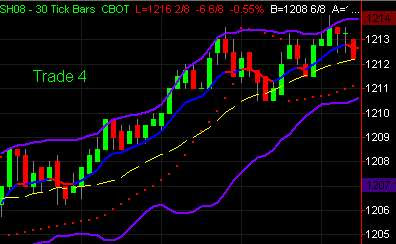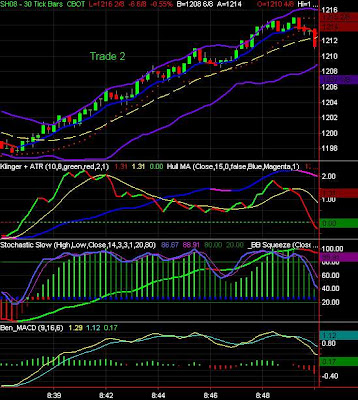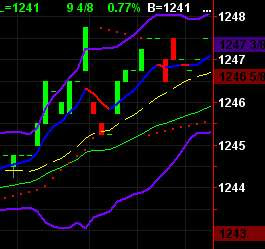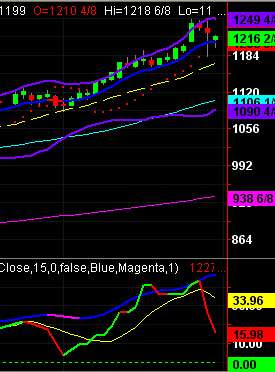
The soybean uptrend on the daily chart is still intact. Prices closed today above the Exponential Moving Average, after closing below it on Friday in electronic trading. However, look at the massive selling, as indicated by the Klinger volume indicator in the subgraph (the red line). If this continues through the week, we are likely to see even stronger selling pressure emerge soon.
Monday, December 31, 2007
Soybean uptrend intact
Trade still open -- I forgot about early close today
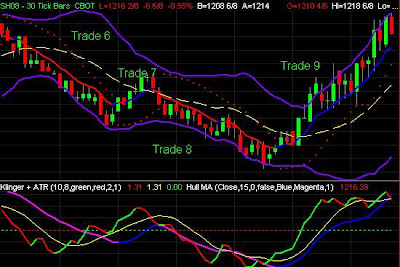
Trade #7 lost money (3 ticks), and trade #8 made only 5 ticks.
Trade #9 is still open! Oops! I may not sleep tonight, so it's a good thing its New Year's Eve. I forgot that the market closed early today, and left my trade open. After 5 minutes, I called the broker to ask what was happening, and he told me the market was closed. Fortunately, the trade is profitable so far. I may not sleep until the market opens tomorrow evening, but I made enough money today that even if the last long trade loses money, I'm not worried. Lesson learned!
Note in this chart how beautifully the Klinger volume indicator hints at a change in direction BEFORE prices change and cross the EMA. Could I ask for a better indicator? I only use the Klinger volume indicator for entry, however. Once I reach break-even, I use the MAs, Bollinger Bands, and MACD for exit signals.
Trade #5

I haven't had this many trades in one trade for about 2 weeks.
Great trade, but rapid reversal! On the left side of the screen, we had already seen a higher high and a higher low, so I entered when the second low reversed, just as the second green candle crossed the yellow dotted line. I exited when the third red candle hit the EMA and turned red.
Soybeans #3
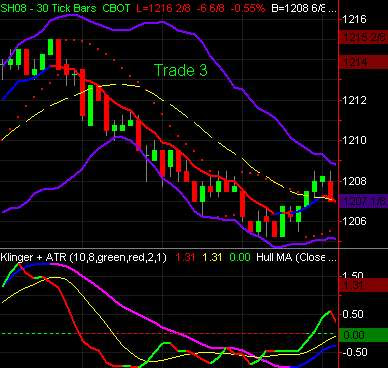
Amazing! Trades are very active, but indecisive today.
I nearly got out on the long green candle that straddled the yellow dotted line at the top left, but by rule is that I won't exit with a loss unless prices reverse to cross back over the EMA and/or close above the candle where I entered the trade, which it didn't do in either case. This was a nail-biter, as many/most of them air, for the first few minutes until the trade becomes profitable and I can set a stop loss at break-even. That is always a relief when I place that break-even stop loss order.
I was reassured, however, throughout this trade that the Klinger volume indicator continued moving solidly down the entire time (see the red line in the subgraph).
Soybeans off to good start
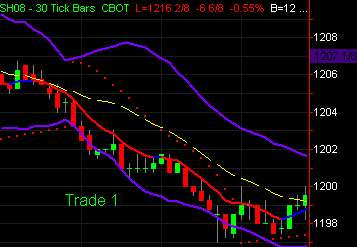
I had two trade prior to this one. The first one lost 6 ticks, and the second one broke even. This one was a very good one.
Friday, December 28, 2007
CBOT reports settlement price of $12.23
The Chicago Board of Trade is showing that its soybean futures settlement price for the March 08 contract was $12.23 rather than the $11.88 6/8 price showing on the charts. I have no idea why this discrepancy is so wide.
Soybean sell-off due to year-end profit-taking, or increased production?
Below appears a link to Bloomberg, where the soybean sell-off today is being attributed to year-end liquidations and increased soybean planting in South America.
To tell the truth, the fundamental reason for the sell-off is irrelevant. All that matters is that it occurred. If we are always trading to give the market what it wants (Bill Williams quote found elsewhere in this blog), then the reason is irrelevant. All that matters is that is occurs, and to trade in sync with the market.
If sales were due to increased production, then the sell-off could be a top, because this news could end the soybean bull market. However, if the sell-off was due solely to year-end liquidations, then fresh buying of soybeans may occur over the next several days. If today's selling was due to both, then it could make for very interesting trading in the coming days. Stay on your toes! It is an interesting article.
Here is the Bloomberg article:
Soybean Futures Fall From 34-Year High as Farmers Boost Sales
Are these two headlines from the same day?

Check out these screen captures of a few headlines related to soybeans. Can you believe they are both from today? One was from early this morning (bottom), and the second (top) was from after the close of the trading session this afternoon. Unbelievable!
Soybean top or year-end profit-taking on thin volume?
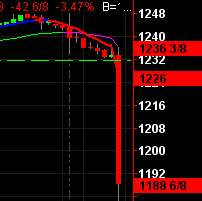 Wow! In the closing seconds of the day, soybeans sold off from the new overnight high, nearly reaching lock limit down, a top to bottom price fluctuation of more than 60 cents! I had to change to a 30 minute chart to give you a good look at what that looked like. I must confess that I took no trades today, including this one. The slow sell-off early on was unconvincing, at best. However, it accelerated (literally) in the closing seconds of the trading session, and I don't place new trades later than 10 minutes before the close of the trading session, especially prior to the weekend.
Wow! In the closing seconds of the day, soybeans sold off from the new overnight high, nearly reaching lock limit down, a top to bottom price fluctuation of more than 60 cents! I had to change to a 30 minute chart to give you a good look at what that looked like. I must confess that I took no trades today, including this one. The slow sell-off early on was unconvincing, at best. However, it accelerated (literally) in the closing seconds of the trading session, and I don't place new trades later than 10 minutes before the close of the trading session, especially prior to the weekend.
Holiday trading is also notoriously thin, so liquidity may become problematic. However, I have found that soybean trading this week has been very liquid and charts have been very smooth, clean to read, and easy to trade. I have had no complaints. These types of sudden price moves and shocks are not uncommon during the sometimes erratic thin trading conditions around holiday weekends.
What was the cause? Without checking the various news sites for fundamentals-related news, I would bet that it was caused by traders liquidating their long positions to take their profits in this calendar/tax year. Readers may recall that I have said that after the parabolic rise in soybean prices on Wednesday, I have anticipated a consolidation of several days or a significant correction. Never did I imagine this, however.
Rick Santelli, on CNBC, said that a tax-year profit-taking retracement was the cause of the sell-off (small compared to this soybean one) in crude oil today, and he implied that the soybean sell-off was for the same reason. Otherwise, this may be a blow-off top, but I have my doubts.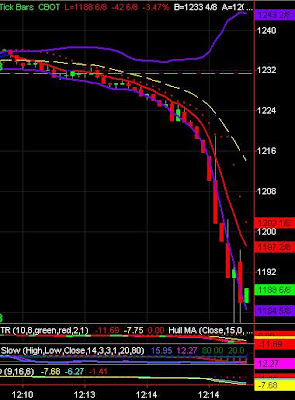
The second chart shown here is my tick chart. Note at the bottom the time markers. The grain markets close at 12:15 pm local time. Thus, this entire sell-off occurred in only about 1 minute of time. One minute! These types of things typically only happen at the end of a year, quarter, or when a global shock hits the system. Soybeans came to within less than one cent of its lock limit down price.
If this sell-off was due solely to profit-taking, then I would expect that many of these same traders will buy new positions after the first of the year, or perhaps even on Monday to carry over into the new year, and the price of soybeans will rise again. This would be a tremendous opportunity to buy into the soybeans bull market.
Soybeans in consolidation, as expected
 Soybeans are still in a consolidation following the parabolic rise in prices earlier this week. I am not trading this downtrend shown in the chart. It is very weak, and eventually, prices will reverse to the upside. This slow, gradual downtrend is too weak to last. Perhaps soybean prices will find support at the low that was struck at the beginning of the trading session, or at the closing price for yesterday's session ($12.31 4/8). Prices are still higher for the day, even with this downtrend as shown here.
Soybeans are still in a consolidation following the parabolic rise in prices earlier this week. I am not trading this downtrend shown in the chart. It is very weak, and eventually, prices will reverse to the upside. This slow, gradual downtrend is too weak to last. Perhaps soybean prices will find support at the low that was struck at the beginning of the trading session, or at the closing price for yesterday's session ($12.31 4/8). Prices are still higher for the day, even with this downtrend as shown here.
Wheat hits top, reverses
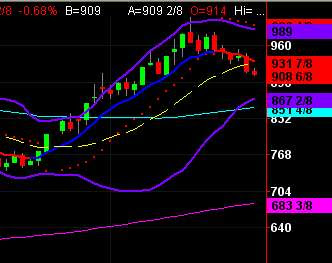
This is the daily chart for wheat. It has reversed and been trading down since last week. Looking at the longer-term daily chart, wheat will probably repeat for the next several days or a few weeks. We should then see wheat prices rebound again. Prices are down again today as well.
Gold bounced off 50-day Moving Average
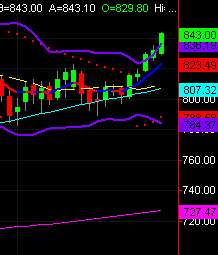
Remember on Monday, Dec. 24, when I predicted that we would likely see a bounce in gold prices off the 50-day Moving Average? It has happened! In the daily chart shown here at right, gold prices bounced up off the 50-day moving average, most likely pushed higher by the weaker US Dollar the tragic assassination of Benazir Bhutto in Pakistan.
Subscribers take note
If you have subscribed to this blog to receive emails of my new posts, please take note that I often place a headline and just a few words of text simply as a place-holder on the blog. That is what is automatically sent out in the emails.
I will later write more and amplify with additional graphics and explanations following the close of my trades. Sometimes, I even have to correct tipos -- oops, I mean typos. Therefore, it is best to check the glob -- I mean blog -- frequently so that you are reading the most accurate and up-to-date posts.
Exchanges raising fees
You may have noticed earlier this week my post regarding fees charged by CME Group. Today, they have announced, along with some of the other futures exchanges, that they are raising their fees higher as of January 1, 2008. As I said previously, the competition of new exchanges being created will be good for traders. Perhaps it will help to cap these fees, or, better yet, perhaps the competition will lead to real-time data being available free and without delay, as I believe it should be. This would bring more traders and greater liquidity into the futures markets -- now wouldn't that be a good idea!
Thursday, December 27, 2007
Up and down trading, but very profitable
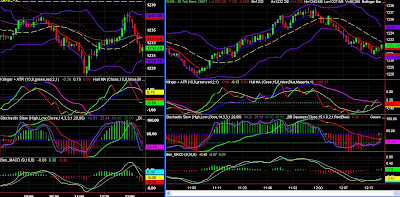 These are ideal trading conditions for swing traders. I had four trades today that averaged at least $200/contract each. I also could have had a fifth, but didn't take it. This includes the last closing trade that occurred in the last 15 minutes of the trading session. Prices closed today down about 16 cents from the high around $12.46 yesterday.
These are ideal trading conditions for swing traders. I had four trades today that averaged at least $200/contract each. I also could have had a fifth, but didn't take it. This includes the last closing trade that occurred in the last 15 minutes of the trading session. Prices closed today down about 16 cents from the high around $12.46 yesterday.
I don't know how anyone could trade using anything but tick charts in these conditions, although the short-term (less than 5 min) charts are also good. Tick charts are so responsive that they demonstrate a shift in market sentiment within 2-5 minutes -- literally! When a fundamentals-related news event occurs, as in today's assassination in Pakistan, the ticks charts will manifest this change to me within seconds, or at most, within minutes. This helps me to nullify the advantage that some traders have who get this news sooner or faster than I do.
Tip:Click on the chart and open it in a separate window to view it in larger and greater detail. I like to open the chart in a separate window and then resize both the blog window and the chart so that I can read the commentary in one window and view the chart in a different window along side of the commentary.
The left chart shown is a 3 minute chart. Note how well the Klinger+ATR indicator gave me advance knowledge of a change in direction. However, the tick chart (shown on the right) is still the best one to trade with. Even with an up and down day, excellent profits can be made with consistency, using short-term and tick charts.
The Klinger volume indicator alone, however, is insufficient to trade with. I use 3 moving averages to help me confirm a change in market direction. The combination of both (Klinger + at least one MA) is necessary to achieve the consistency necessary to trade successfully day after day. The 3 moving averages are shown in the charts as follows:
- This top chart, where the candlesticks appear, has a red and blue 8-period Exponential Moving Average. It also includes Bollinger Bands, which I use primarily as dynamic support and resistance.
- The 1st subgraph shows the Klinger+ATR indicator, but it also shows a Hull Moving Average, which is a smoothed EMA. It is appears in magenta and blue.
- The 2nd subgraph shows the Bollinger Squeeze indicator as a red and green histogram. This subgraph also shows the slow stochastic and the Gaussian filter, which is also another smoothed EMA, but with very different settings than the Hull MA above. Interestingly, the two behave very similarly, which I take as a confirmation.
In addition to the Klinger and moving averages, I also require confirmation by a crossover of the Bollinger MA (yellow dotted line in top graph), which is a 20-period Simple Moving Average, and a crossover of the EMA in the 3 minute chart also. The movements on trading days like today are superb for day-trading swing traders like me.
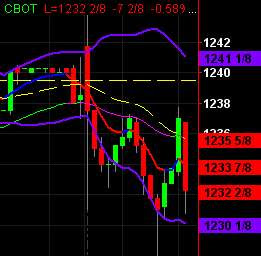
In this last chart, we see 15 minute candles. If I had been trading this chart, I almost certainly would have lost money, since it is so erratic. I trade shorter-term charts because I simply don't have the patience to wait for longer-term trades to become profitable. (Contrast this chart at right with the top right chart at the beginning of this post. The other one is much smoother and easy to follow because it is based upon trades coming into the exchange rather than time intervals. I also can sleep better at night by day trading and closing out my trades before markets close each day.) I am also unwilling to accept the risk necessary to place wider stop losses. I rarely have a stop loss of more than 5-6 ticks.
As expected - slight retracement, consolidation
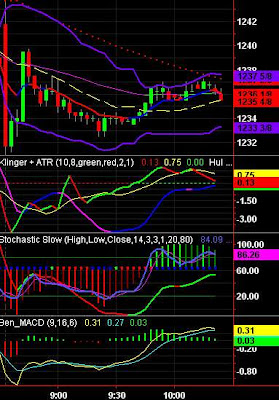 Today is starting as a rather mundane and typical trading day, and was expected following the rapid rise in prices yesterday(see my prognostications from yesterday). I would expect this to continue for a few days, so that market expectations can catch up with the record price rise yesterday.
Today is starting as a rather mundane and typical trading day, and was expected following the rapid rise in prices yesterday(see my prognostications from yesterday). I would expect this to continue for a few days, so that market expectations can catch up with the record price rise yesterday.
It would be nice to see a little more volatility, because price fluctuations are low enough that some trades may lose money. However, some profits are still possible.
Wednesday, December 26, 2007
Sum-up of 12/26 soybeans trades
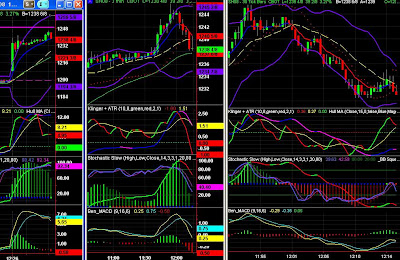
Today was the most profitable day I have had this year in trading soybeans. What a great way to finish the year!
Prices rose more than 46 cents from Monday's close. In the left (15 min) chart, the rise in soybean prices is clear and unidirectional. However, prices rose relatively little after the first 15 minutes of trading. On the 3 minute chart in the middle, you can see clearly the two trades I took today (one long, one short). The chart farthest to the right (tick chart) shows my last trade in the last few minutes of the trading day. While this small trade may appear minuscule on the 15 minute chart, it was a trade worth more than $300 per contract. And that's just the SMALL trade at the end!
Today was quite close to a textbook example of a typical trading day for soybeans. The day often begins with a short and small retracement or consolidation, following which a rise to higher prices occurs rapidly. After consolidation during the middle of the trading session, there is a sell-off and prices go down in the last 15-30 minutes of the trading day. This sell-off is almost certainly a result of traders liquidating their positions to take profits.
This chart is the most common pattern for trading soybeans.
There is one element of this chart, however, that is troubling to me. Perhaps due to light trading conditions following the Christmas holiday, the rise in prices today was parabolic in nature, and is usually subject to a sharp retracement, perhaps when regular trading volumes return after the first of the new year. This phenomenon may also manifest itself in a consolidation for several days, during which erratic trading conditions prevail. This consolidation pattern occurred just a week or two ago, following another parabolic rise in soybean prices. If past is prologue, perhaps this pattern will ooze from the market again this time.
This rapid price rise is highly reminiscent of the rapid rise of the EuroUsd in December 2004. In January 2005, the EuroUsd began a retracement that lasted throughout 2005. A rapid and unrestrained rise in prices like we have seen today in soybeans may also lead to a sharp snap back, like a rubber band that has been stretched too far, and now snaps back painfully as it slips from one's fingers.
Commodity prices rise with US Dollar vulnerability
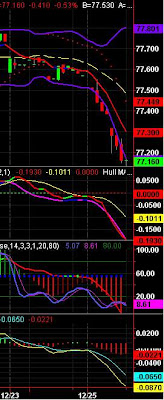
Along with soybeans and gold, corn and crude oil have also risen to multi-week highs this morning. The USD has shown more vulnerability to the down side (see the chart of the US Dollar index, which is wrongly dated 12-25). There is a significant, if not strong, inverse correlation between the US Dollar and many commodity prices, especially commodities that are connected to inflation (gold) or fuel (soybeans, corn, crude oil). Even wheat was up 16 cents before collapsing later in the session.
Commodity inflation continues to swell with strong prices throughout the sector. What will the Fed do?
The Fed's Behavior
Probably they will continue to throw money at it, based upon observation of past Fed behavior. One must keep in mind that the Fed governors are all career bankers (except Bernanke, who is an academic), so group-think is their mentality. They operate with group-think banker's blinders in crises, so they are likely to react as the have in times past. Perhaps they don't realize that this kind of thinking and reactions are the cause of the problem, not the solution. The more they do it (create more and more money, which they call "liquidity"), the more they will reinforce the inflationary bias of the markets, and the more they will inject turmoil into the financial sector of the economy. They are amplifying a latent sense of panic that is building, and the more they interfere, the more they multiply this latent panic. They are almost guaranteeing a recession by interfering and creating such turmoil. They apparently don't realize that with so much Feddling (Fed + meddling = Feddling) they are creating a sense of panic in the markets. Ultimately, panic leads to greater turmoil and will eventually cause investors to remove money from the markets. I don't think this has happened en mass yet.
Unfortunately, the current election cycle is going to create even more pressure on the Fed to "do something!", so they probably will. Congress may act as well, which will also create more turmoil still. Turmoil in the financial markets appears to be the operative word to remember for the foreseeable future.
Soybeans approach lock limit before retracing!
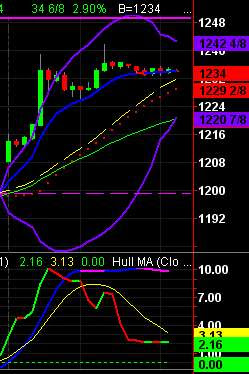 Soybean prices today swelled the most I have seen for a single day in the time I have traded them, increasing more than 42 cents before retracing somewhat. Lock limit is 50 cents for soybeans. In my trading soybeans, I have never seen this lock limit reached. The Monday close is shown as the pink dotted line in this chart, and the lock limit price is the pink line at the top of the chart.
Soybean prices today swelled the most I have seen for a single day in the time I have traded them, increasing more than 42 cents before retracing somewhat. Lock limit is 50 cents for soybeans. In my trading soybeans, I have never seen this lock limit reached. The Monday close is shown as the pink dotted line in this chart, and the lock limit price is the pink line at the top of the chart.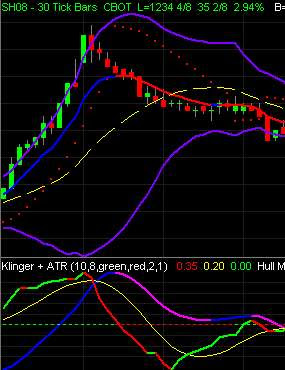
Even though selling pressure is quite high, as evidenced by the Klinger volume indicator in the subgraph shown, prices have not abated very much. This tells me that we are seeing some profit-taking, but that prices remain well supported for further price rises. I will go long again with additional positions when the Klinger and EMA indicators on my 2nd chart both turn UP again on the tick chart shown below. They appear poised soon to do that.
Gold moves significantly higher 2nd day in a row

Gold futures prices have risen dramatically for the 2nd trading day in a row, nearly $30 in the past 4 trading sessions. This increases the inflation bias that the Fed must deal with.
As you can see from my previous blog posts, a major inflection point was anticipated, and this may be the beginning of another leg in the gold bull market. Here is a link to an article on Bloomberg:
Gold Rises in Asia as Crude Oil Gain Boosts Inflation Hedge
Needless to say, the price of crude oil has also risen, once again to well over $96 per barrel. This is very bullish for oil prices, and bearish for the U.S. economy and the U.S. dollar.
Stock prices are down marginally this morning due to disappointing retail sales during the Christmas season, being reported by Mastercard at the low end of its downwardly-revised forecast. Also, in a related news story, housing prices are down more than expected. It seems hard to believe that softer home prices was unexpected. What world were those surveyed economists living on? It certainly wasn't earth!
Monday, December 24, 2007
Competition in the Futures Exchanges!
In an important news event, JP Morgan Chase has indicated that they, along with a conglomerate of other large banking institutions, will soon open a new futures exchange in competition with CME Group. CME Group owns both the Chicago Mercantile Exchange and the Chicago Board of Trade. The competition should benefit futures traders. I hope that it will result in reduced fees.
I have considered it to be a hit on traders, and a potential opening for more competition, that CME charges exchange membership fees for BOTH CME and CBOT, even though they are both owned by the same parent company. NYMEX does the same thing with NYMEX and COMEX, requiring traders to pay fees to both, even though they are the same company. This, I believe, needs to end, and I hope this competition will advance that time line somewhat. Here is the article on Bloomberg:
CME Falls After Report of JPMorgan-Backed Exchange
Significant: Gold stays above 50-day Moving Average
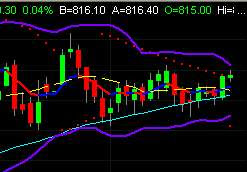 Note here that the price of gold, which rose significantly on Friday, is continuing to close above its 50-day Moving Average, shown in this chart as a light blue line. If gold is going to maintain its lofty prices, it should surge to even higher prices soon. This could also be the trigger for the next leg up in gold prices, perhaps initiated by additional inflation data showing that inflation is becoming unmanageable by the Fed. The Fed is very concerned not only with the inflation data, but even more importantly, with the inflation expectations created in the minds of consumers.
Note here that the price of gold, which rose significantly on Friday, is continuing to close above its 50-day Moving Average, shown in this chart as a light blue line. If gold is going to maintain its lofty prices, it should surge to even higher prices soon. This could also be the trigger for the next leg up in gold prices, perhaps initiated by additional inflation data showing that inflation is becoming unmanageable by the Fed. The Fed is very concerned not only with the inflation data, but even more importantly, with the inflation expectations created in the minds of consumers.
On the other hand, also take note in this chart that the Bollinger Moving Average, shown here as a dotted yellow line, is turning DOWN. It is also a hair's breadth away from crossing under the blue 50-day MA. Many professional traders use the crossing of the 20-period Simple Moving Average (which is the same as the Bollinger MA) and the 50-day Moving Average as a trading signal. I personally don't, but I watch them because I consider them to be an important indicator as a potential inflection point. It should signal a big price shift, either up or down, in the not-too-distant future (a few weeks).
Will Friday's price gush in gold be the beginning of the next bull leg, or the last sputter of an enfeebled commodity? Stay tuned...
March soybeans surpass $12.00
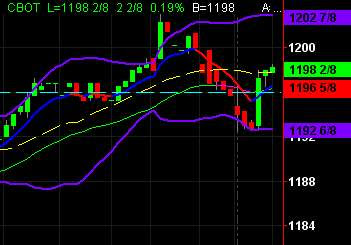
March 08 soybeans breached the $12.00 per bushel price handle during overnight, pre-holiday trading. This is not unexpected, especially since the new front month contract (March 08) is priced approximately $.20 higher than the Jan 08 contract. Volume today (12/24) is relatively light, but certainly sufficient for good trading.
This is not uncommon in the financial markets. Thin volume tends to create ideal conditions for amplified movements and erratic volatility. Throughout 2004 a few years ago, the EURUSD hit its greater and greater highs, which were amplified during the light volume of December trading. In early January 2005, when normal trading volume resumed, the USD corrected and rose for most of the following year.
I have been somewhat hesitant to trade soybeans and other grains during the trading days surrounding the Holidays, but I feel that trading conditions have been excellent thus far. In the future, I would have no hesitancy to trade grains during the Holidays. Liquidity has remained strong and solid throughout, erratic price adjustments haven't appeared, and price movements have not appeared to me to be abnormal. These are all conditions that have dissipated my hesitancy, and in future years, I would eagerly place trades throughout the Holiday season. That's good, because I really like to trade, and I genuinely miss trading on holidays and during vacations.
Friday, December 21, 2007
Flurry of activity and bullish prices to close week
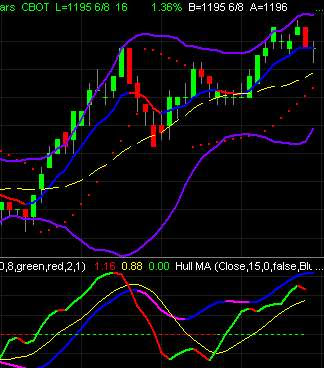
The bulls have broken through once again (had we any doubt?) to close the week at what appears to be a new closing high, and perhaps a new record high. The soybean bull continues unabated! (See Chick Goslin's Law #2 from my earlier post today.)
I exited at the first red candle after the run-up in prices. This pattern, when confirmed by lower prices, is very close to a bearish engulfing pattern. A true engulfing pattern would have shown the open price above the close for the previous candle. However, in highly liquid markets like futures, the closing price for one candle is frequently the opening price for the next one. Many candlestick pattern purists trade primarily stocks, where gaps and price jumps are common, if not the rule. In futures and currencies, where liquidity is better and price depth is more ample, gapping prices are quite rare, although certainly not unheard of. Thus, a purist interpretation of candlestick patterns may not be appropriate for futures. We adapt.
Needless to say, I missed out on additional profits, but at the close of the session and week, I wasn't going to re-enter the markets so close to the close. I wish I had, but no one trades perfectly. I certainly could have. My rule is not to place a new trade after 2:05 pm EST. The green candle following my exit occurred at 2:02 pm EST.
Soybean consolidation emerges
Note the green and red dots at the zero line on the histogram for the Bollinger Squeeze indicator (bottom subgraph, both charts). Note also that the 3 minute chart shows flat Bollinger Bands, MAs, and prices. At the same time, the tick chart has gone dead. There is little activity, which on a tick chart indicates that there are few buyers or sellers. There are no buyers or sellers, so tick-based candles don't continue to tick by, while on the time-based interval chart (left) tiny candles continue to tick the time by as it passes. The market is indecisive, and no one is willing to commit. That includes me! Therefore, now we wait.
This is NOT a time to go to lunch. Once the Bollinger Bands are breached, a flurry of buying or selling activity will emerge very rapidly as volatility rapidly rises again to a fever pitch. This would create the perfect trading conditions that Philippe Cahen describes in incredible detail in his book, Analyse Technique et Volatilite.
Note also, however, that both the Bollinger Squeeze indicator (the histogram has changed from bright green to dark green, indicating a loss of buying momentum) and the Klinger indicators (red downward-slopped line in the 1st subgraph below prices) are universally indicating selling pressure. Corn, on the other hand, is showing pressure to the upside right now (not shown).
Chick Goslin: Three Natural Laws of Trading
The Three Natural Laws of Trading
- The future is unknown
- Continuation is more likely than change
- Prices fluctuate
Law #1 above is manifest in this next graphic (see below with further explanation) at a point of uncertainty. Law #3 is obviously a constant. If I was forced to place a bet, which I am, I am going to bet that Law #2 will re-emerge and become dominant -- eventually. I am going to prepare or at least expect to go long, but will exit my short position if prices stagnate into a consolidation (I have placed a stop loss to prevent me from losing money). A consolidation would at least allow me to take some limited time picking an optimally-profitable exit point. Prices don't appear to be poised to continue downward for now, so I will want to do it fairly soon, before buying strength re-emerges.
Given Laws 1 and 2 above, how is it possible to make profits in the futures markets? Chick provides a much better answer than I ever could in his book.
Conflicting Signals = Market Indecision
There are some conflicting signals in this chart. Interestingly, the chart for corn today looks nearly identical. Wow!
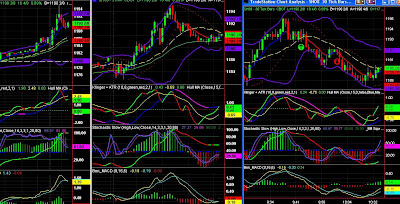 On the 15 minute and 3 minute charts, prices are showing dynamic support at this level via the EMAs. We are also seeing strong buying in the 3 minute chart Klinger indicator (see the rising green line in the middle chart, 1st subgraph below the candlestick chart). If the Bollinger Squeeze indicator (in the 2nd subgraph, with the histogram and coupled with Stochastics) begins to show one green and then a series of red dots, I will look to exit quickly with a small profit. Probability appears poor for continued downward prices, especially since the overall trend is UP. My short position is just slightly profitable, and I'm not going to risk it going negative. A much higher probability is for prices to consolidate (go flat), or for the uptrend to resume. The Bollinger Bands and Bollinger Squeeze indicators will tell me which (uptrend or consolidation) will emerge.
On the 15 minute and 3 minute charts, prices are showing dynamic support at this level via the EMAs. We are also seeing strong buying in the 3 minute chart Klinger indicator (see the rising green line in the middle chart, 1st subgraph below the candlestick chart). If the Bollinger Squeeze indicator (in the 2nd subgraph, with the histogram and coupled with Stochastics) begins to show one green and then a series of red dots, I will look to exit quickly with a small profit. Probability appears poor for continued downward prices, especially since the overall trend is UP. My short position is just slightly profitable, and I'm not going to risk it going negative. A much higher probability is for prices to consolidate (go flat), or for the uptrend to resume. The Bollinger Bands and Bollinger Squeeze indicators will tell me which (uptrend or consolidation) will emerge.On the other hand, the MACD on the 15 minute chart has turned down, and the 15 minute Klinger appears to indicate further selling, despite the green color of the current candle. Times of conflict in the charts tend to favor a consolidation, at least temporarily, until the battle between buyers and sellers is resolved.
End of first trade, start of 2nd
Another Head and Shoulders Top
This is the tick chart again. I honestly don't know how people trade without a tick chart. It measures orders coming into the system rather than by time intervals.
This chart shows a head and shoulders top, which is very common in soybeans trading. Head and shoulders tops weren't one of my favorite candlestick patterns, but they work because they show a marked change in both sentiment and the underlying trend. The green arrow is the position where I exited my long position (prices crossed the dotted yellow Bollinger Moving Average line, which appears almost white in this screen capture), and the bottom of the red arrow is where I entered my short position. The green arrow was also the place where prices crossed the 8-period EMA on my 3 minute chart. I am a little worried that this pattern is showing up so early in the trading day. It may suggest other unexpected events later, perhaps a consolidation(?). I need to be prepared for more unexpected or difficult conditions. If prices go flat, I won't take a new position until a new trend becomes clear. There are times when NO position is the best position.
(Sorry, but Tradestation doesn't really have very good arrows in its software. In the first few days of my blog, I attempted to add better arrows and explanations using MS Visio, but it was too time-consuming, so now, I just use the Tradestation graphics and provide explanations textually.)
Trading Multiple Contracts
One of my emerging trading habits is to trade contracts in even-numbered blocks (2, 4, 6, etc.). As soon as the first signs of a turn in the opposing direction manifest themselves in the Klinger indicator, I exit 1 contract, taking my profits. If this indicator turns before the position is profitable, I exit both contracts. However, by taking profits on one contract and leaving the other, I am providing myself with a profit cushion, and I am leaving a longer-term position in place for the continued rise in prices. There is one problem with this, however: in a rising trend, I can no longer take short positions, even temporarily. Thus, it is a somewhat double-edged sword. I am not sure which is the more profitable way to trade.
In an overall bullish trend, I will NOT take add-on positions after my original short position. Retracements tend to be short-lived, and are not worth the additional risk. Thus, my risk is more limited and positions tend to last for shorter periods. I am quicker with the exit trigger, so-to-speak, on a retracement.
Soybean bullish pattern
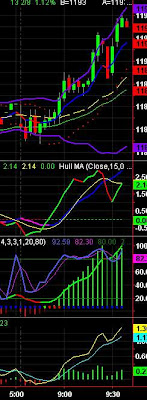 I've have noticed a common pattern in the rise of soybean prices. After a rocky open in which prices fall briefly or (today) consolidate, prices then begin a solid rise to new or near-new highs. Then, we tend to see a sell-off later that erases a good portion of the gains, but doesn't retrace all the way to their lows. This makes for a solid, sustained, and healthy uptrend in soybean prices. This type of pattern is very typical of soybeans, as seen in the first chart at right (3 min chart).
I've have noticed a common pattern in the rise of soybean prices. After a rocky open in which prices fall briefly or (today) consolidate, prices then begin a solid rise to new or near-new highs. Then, we tend to see a sell-off later that erases a good portion of the gains, but doesn't retrace all the way to their lows. This makes for a solid, sustained, and healthy uptrend in soybean prices. This type of pattern is very typical of soybeans, as seen in the first chart at right (3 min chart).
The chart at right represents two trades for me due to the dip you can see more prominently in the 2nd chart below (30 tick chart).
Note: I started trading the March 08 contract today. Open interest is more than double the January contract, but daily volume is still below the January figures. However, I like to stay a little ahead of falling volume, so I have now changed to the March contract, which the Chicago Board of Trade has shown on their home page as their dominant soybeans contract for approximately one week now.
The rollover to the March contract increases the likelihood that soybeans will reach a higher price due to contango. We are very close to reaching the $12.00 soybean handle that has been speculated in the media somewhat. Most soybean traders that I know have been expecting -- even predicting -- this for awhile. One report I read last week said that a price of $12 would be required to encourage more farmers to grow soybeans, replacing some of the acreage that corn has garnered over the past year. Interestingly, as farmers change acreage from corn to soybeans, soybean prices may moderate, and the lower production levels of corn should be bullish for corn prices.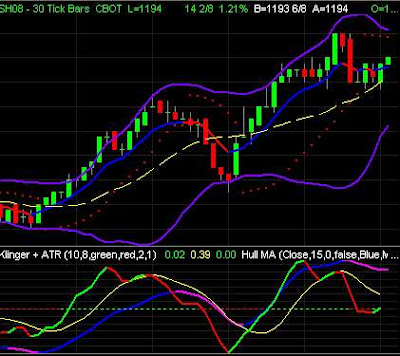
This second chart is beginning to show some signs of price weakness and the potential signs of a top. Note what appears to be (not yet, but may develop into) a possible divergence on the Klinger+ATR volume indicator (1st chart, above) . The yellow (on my charts, but in the screen captures here on my blog, it appears almost white) "trigger" line, which is an MA of the Klinger line, has already turned bearish, and the Klinger indicator is below it. The rather deep correction of that one red candle is indicative of further weakness in the price structure, and I am anticipating the strong likelihood of a price correction downward before the bullishness continues its uptrend.
More inflation on the way! Thank you, Fed!
Core PCE for November shows growing inflation concerns, especially in the yearly rate. And American consumers go even deeper in debt. Here is the story at marketwatch.com
Consumers outspend incomes in November
All the more reason to keep buying commodities!
Also, did you see the news this week that the ECB injected 500 billion Euros of newly-created fiat money into the financial markets this week? $500 BILLION! And the BOE injected 100 billion Pounds? Those are enormous amounts of new money. I was flabbergasted. If that's not inflationary, what is?!
Wall Street will love it, because most of that capital will be injected into the financial markets. But it all spells more inflation, and more commodities profits. And fools gold corporate profits. But it may temporarily and partially restrain the US Dollar's fall, if that may be considered a thin silver lining.
Thursday, December 20, 2007
Two soybeans trades for the day
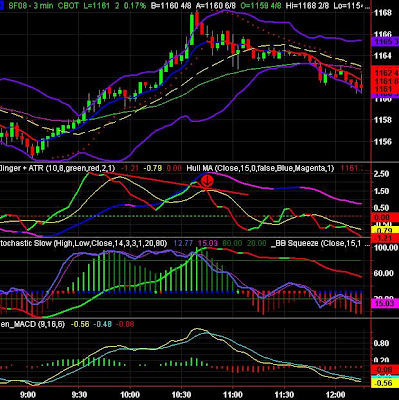
As a trader, I don't try to anticipate or position myself before the move begins. Remember what Bill Williams said, "...the Holy Grail is simply wanting what the market wants." Once I create in my mind a bias, I close my mind to what the markets wants, and that bias creates a greater likelihood of sabotaging my trading effectiveness because I want something that the the market doesn't. Thus, I make errors in judgment and bad trades! I give the market what it wants and strive to forget and nullify any biases. Go with the market flow!
Very few people enter a trade precisely at the top or bottom, and no one does it with any consistency. Far more lose money trying to do so.
I was able to make two very good trades today. One was excellent. I consider a trade that earns more than $400 per contract to be a good trade. About 50% of my trades net less than $100, so when a trade makes more than $200, it's a good one. If it nets more than $500, its a great one. Only about 2-3 trades a week net more than $700 per contract. But I have to be "in it", to "win it".
Today's trading is an example of why I like trading soybeans so much.
Soybean top for the day
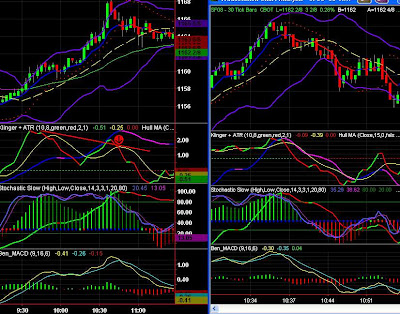 Note the top is shown in the left-hand side chart with the bearish divergence on the Klinger+ATR indicator. I have drawn a red line with a red downward arrow to indicate where it is. This same top is shown in the tick chart on the right as a head and shoulders top. I got out just before prices crossed the dotted yellow line on the right chart, which is the Bollinger MA (20 period SMA). The short trade on the right is a bit rough, but profitable so far. I shorted at the bottom of the first green candle that straddled the EMA and the Bollinger MA on the right chart. It will most likely accelerate downward as the close of session approaches.
Note the top is shown in the left-hand side chart with the bearish divergence on the Klinger+ATR indicator. I have drawn a red line with a red downward arrow to indicate where it is. This same top is shown in the tick chart on the right as a head and shoulders top. I got out just before prices crossed the dotted yellow line on the right chart, which is the Bollinger MA (20 period SMA). The short trade on the right is a bit rough, but profitable so far. I shorted at the bottom of the first green candle that straddled the EMA and the Bollinger MA on the right chart. It will most likely accelerate downward as the close of session approaches.
Soybeans: Born-again bulls!
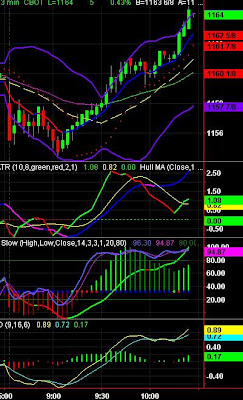 The soybean bull market builds again, but hasn't yet reached its most recent high prices, which are still about $.10 higher than current prices. After a much-needed retracement following last weeks' parabolic rise in prices, it appears that the next leg higher is now beginning to emerge. I fully expect that $12 soybean prices are not far away!
The soybean bull market builds again, but hasn't yet reached its most recent high prices, which are still about $.10 higher than current prices. After a much-needed retracement following last weeks' parabolic rise in prices, it appears that the next leg higher is now beginning to emerge. I fully expect that $12 soybean prices are not far away!
Soybeans show signs of life!
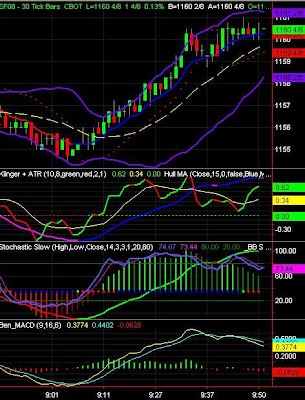
First strong trade of the day. This one is looking weak, but I won't exit until prices close and stay below the 8-period EMA.
I have had a couple of other soybeans trades, but for a total of only 6 ticks. This is the best one so far.
Wheat overnight also shows good movement
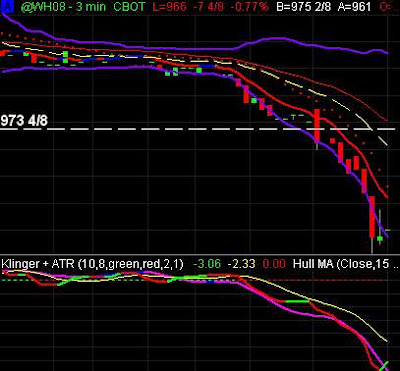
The sell-off in wheat also shows good movement and reasonable good liquidity. We'll have to see what the session open looks like. I don't typically trade during the evening hours because spreads widen, especially this week. Thin pre-holiday trading has widened spreads during evening trading to 4-5 ticks. If I have to pay 4-5 ticks on entry, another 4-5 ticks at exit, plus slippage of one tick each direction, it becomes almost impossible to make a profit. Statistically, traders make their most profits on less than 5% of their trades. Most trades, the primary objective is to prevent loss. Repeated entries and exits are necessary to be in position to profit from the stronger moves.
The S&P 500 futures look fine! Good liquidity

Good liquidity and smooth trading is of critical importance to a day trader. Without it, trading is unreliable and profits can't be predicted. Note in this chart the S&P 500 Mar 08 contract. It is very smooth and is much easier to trade than the futures in my last post. I only trade futures where the charts look smooth and reliable. Trading others is financial suicide. This is the first thing I look for at the beginning of the trading day. It also allows me to keep a cool head and prevent emotional reactions to market noise.
While I personally don't like to trade the stock index futures, it is more important to me to get good liquidity with smooth trading than to always trade just one or two favorites. I will probably trade the S&P 500 today.
I don't like to trade the stock indexes because they often move so rapidly that I have a difficult time getting in and out of my trades fast enough. The grains move somewhat more gradually, so I can get better executions, both on entries and exits.
Markets continue to appear erratic, except...

Looking at soybeans overnight, the charts appear to be unusually erratic. This is fairly typical for pre-holiday trading. If the open doesn't show stronger liquidity, I may be finished trading until after the holiday. Ugh! I hate to miss trading days, and with two holidays back-to-back just one week apart, many traders take a vacation, so regular trading with good liquidity often doesn't begin again until the first full week of the new year. One of the troublesome issues I'm dealing with today is whether to continue trading the January 08 soybean contract, or change to the March 08 contract. The March contract has much more Open Interest, but in electronic trading, the January contract still has greater volume. This perhaps may be an additional factor in the poor liquidity showing on this chart. This transition may continue for the next day or two.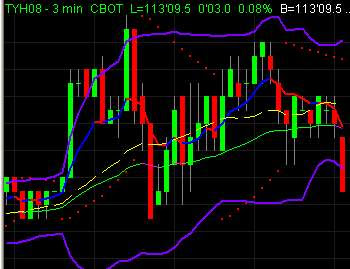
Image #2 shows the 10-year treasuries this morning. It is also too erratic to be traded. Treasuries are one of the most liquid of a futures contracts, and the 10-year is the most liquid of the treasuries. Only the S&P 500 futures can match it for liquidity, which I measure by a combination of Open Interest and volume.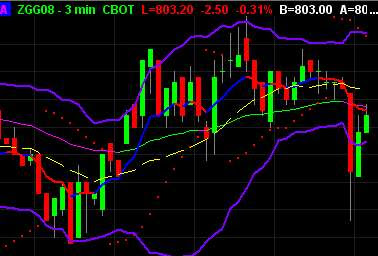
The last image is of CBOT gold. I don't trade COMEX gold because I have to pay a separate fee of about $50 just to trade COMEX gold. Since COMEX was purchased/merged with the NYMEX, you would think that a single fee would be sufficient to trade both. But the charge fees for each one. Thus, I discontinued my membership with COMEX, and only trade gold on the CBOT. Open Interest on the CBOT is much less, but liquidity is excellent and fills are superb. Why pay more money for the same service?
Wednesday, December 19, 2007
Flu today... gone tomorrow?
Let's certainly hope so. I've had the flu today. However, much of the futures market was fairly quiescent and lethargic, perhaps due to the impending Christmas Holiday and many traders taking time off. Perhaps this was a blessing in disguise, because stolid markets are when I am most likely to lose money. Volume is often low and prices are often unusually volatile in the days immediately before and after major holidays. However, I plan to trade through the end of the week, if I am feeling well.
Tuesday, December 18, 2007
Stagnant day in grains
The day was mostly stagnant in day-trading grains today. I will hope for better conditions tomorrow. Eventually, the bull market in grains will re-emerge. We just have to wait it out!
If grains won't cooperate, then...

let's short the Aussie!
Saving Money Trading Forex
The Chicago Mercantile Exchange allows futures traders to trade Forex with tighter spreads and lower commissions.
Most of the Forex brokers claim that their trading is commission-free, but this isn't entirely truthful. Weren't they ever taught by dear old Mom to tell the whole truth? Instead of charging a commission, they just widen the bid/ask spread and make their profits that way. It is much more expensive for a trader to trade that way, because that bid/ask spread ultimately comes out of of the trader's pocket! There is no free lunch, and we traders are paying for the lunch!
I have come to learn that it is to the benefit of traders for orders to be processed through a centralized exchange like the CME. Since all orders are processed through the exchange, spreads are generally only 1 tick for liquid futures contracts. With a commission of only about $4 per trade, the break-even point is only 1-2 ticks.
Contrast that with the typical Forex broker. They charge no commission (so they say), but instead, they widen the bid/ask prices to 3-5 pips. Thus, your cost is at least $30-$50 just to break even. You must make from 4-6 ticks/pips before you can make a profit. And that's assuming there is NO slippage! This is the dirty little secret that the brokers of the retail Forex industry hope traders will never learn. They make their livelihoods from trader ignorance! But ultimately these brokers shoot themselves in the foot; because the churn in retail Forex traders is so high, they must constantly replace their client base. Their marketing costs sky-rocket, and they spend astronomical amounts of money seeking to constantly bring in new business. No wonder they widen their spreads so much!
Which would you rather do? Trade the retail Forex market, where you must make $40-$50 just to break even, or trade the currency futures through the CME, where you need to only make 1 tick ($10-12.50) to break even? The answer should be obvious!
As an example of this, my own broker funnels their Forex trades through one of the world's largest, most prominent Forex brokers. If I trade Forex (major crosses) through my broker, they charge me $2.67 per trade with a bid/ask spread of about .5-1.5 ticks (pips). However, if I trade directly with the same Forex broker at the retail level, instead of through my own at the wholesale cost, that same Forex broker widens the bid/ask spread to 3-5 ticks (ticks=pips), a difference of at least $30 in cost to the trader! The orders are both processed through the same company!
That's why I trade Forex through the Chicago Mercantile Exchange, where I pay about $4 plus 1 tick spread on futures processed through the CME exchange, rather than trade Forex through a retail Forex broker. I can also trade through my futures account rather than open a separate account just to trade currencies. It all comes down to MONEY - MY money!
In a business in which most people lose money, I'm not going to throw money away by spending more than I need to. The bid/ask spread is of critical importance in trading profitably. The tighter the spread, the more money in MY pocket.
Trading quotes - Bill Williams
Day starts turbulent for grains 12-18
While soybeans have shown some weakness this morning, wheat and corn have been largely stagnant, which may be indicative of a bottoming out.
Even the soybean weakness shows some lack of strong conviction, perhaps because the overall uptrend is intact. However, the retracement or consolidation that I have hinted at over the past week is being demonstrated by soybeans in early trading today. I don't know how long it will last, but I feel that this is a healthy retracement for soybeans over the short term (hours or days, not weeks). Soybeans and the other grains were looking somewhat overbought after last week's run-up in prices.
Monday, December 17, 2007
Soybeans stagnant today
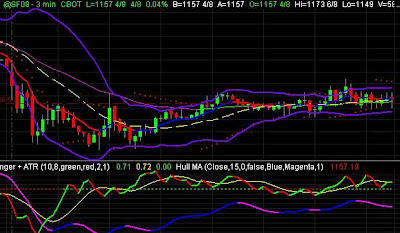 Soybean prices were stagnant for most of the trading day today. Days like today are difficult to make profits.
Soybean prices were stagnant for most of the trading day today. Days like today are difficult to make profits.
Treasury Sec. Paulson: "Market Failure"
Financial Market Stress
Last Friday, I wrote an article in this blog advising fellow traders that the financial markets' turmoil is increased by government interventions. Now, in the following article on marketwatch.com, others are echoing the same sentiment. In addition, Treasury Sec. Paulson is traveling the country to promote his plan to help troubled mortgage borrowers. He startled me when he said that without this intervention, we could experience "market failure". I could hardly believe my ears that he would sound so alarmist until CNBC printed the same at the bottom of the screen, confirming to me that I had not heard him wrong.
All I can say is that I'm glad I'm NOT trading stocks or stock futures right now. I am going to build my short positions in the financials, housing, and some emerging markets ETFs.
From marketwatch.com this afternoon:
Here is the entire article. There are some startling things in it that are worth the read:
Gold's Odd Price Move
Nice trend today in corn
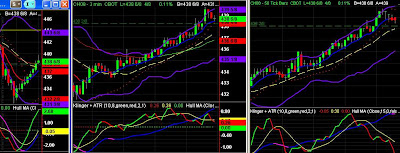
After its retracement with the other grains today, corn is showing a very nice trend upward. This chart shows all three time frames (15 min, 3 min, 50 tick) of my corn triptych.
So far today, after a sympathy retracement among all the grains (corn, wheat, soybeans), the corn price has recovered and moved higher, wheat prices have continued to sink (poor manic-depressive wheat), and soybeans prices have gone flat. I lost a few points today on soybean trades. The later consolidation became so tight I couldn't even make a few ticks on my trades. I couldn't even break even. If it wasn't for corn, I would have lost money for the day.
Trading other futures
Typically, if my preferred soybeans go flat and consolidate, I will check charts for my other favorite futures until I find one that shows promise. I usually check soybeans first, then wheat, corn, gold, treasuries, and currencies, usually in this order.
When gold is consolidating, as it has been in the past few weeks, it becomes more erratic on the longer-term charts than some other commodities. However, on very short-term charts, it can be very enjoyable to trade, because shorter-term charts for gold have a certain orderliness that some other commodities don't have. I don't know how else to describe it. For example, I enjoy trading gold on CBOT. However, after the European markets close about 12:00 pm EST, gold sometimes can be thinly traded (but not always), so I am reluctant to trade during those post-European hours. I have been trading long enough that now, I can take a quick glance at the charts and decide instantly if it is worth trading.
The key to selecting which futures to trade is to trade ONLY the most liquid ones. Liquidity ensures that spreads are tight, executions are quick, and slippage is minimal. All the financial brains in the investment banks should have know that this is "Derivatives 101". You don't create financial instruments for which there is no market, no market value, and no liquidity. Duh!
Soybeans update Monday 12-16
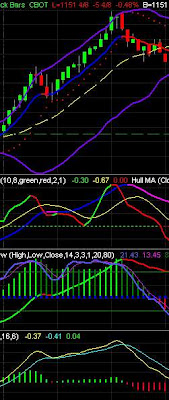
After hitting another new high during overnight trading near $11.77 per bushel (see the first chart at the top showing the new high), soybeans, like the other grains, traded lower and retraced. I did NOT trade this new high, by the way. I have noticed that prices frequently reach new highs during the evening trading hours. However, I am somewhat reluctant to trade these hours because spreads widen to 3 ticks. If you have a spread of 3 ticks at both entry and exit of a trade, it is costing you $75 to execute and exit a trade. That must be strong momentum to risk that much in addition to your stop loss on a single trade, in my opinion.
Off about 25 cents from its high, soybeans prices have now found support at about $11.50 and are showing signs of moving higher again. This $.25 retracement is shown in the second picture below. Clicking on the picture, by the way, will open a larger version of it in your browser window. I usually try to name the pictures in such a way that they describe and match my writings here.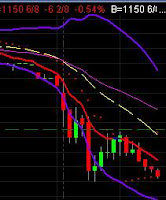
I have been feeling over the past few days that the rise in soybean (and other grain) prices has been too steep for a healthy bullish trend. Therefore, a retracement or consolidation for a few days should be expected. If prices rise too rapidly, then a sharp (painful) pull-back, either temporarily, or as a complete reversal, can be expected. A healthy trend tends to be more gradual rather than parabolic in nature. This retracement today in soybeans is a healthy one and to be expected.
This third chart shows what appears to be a bottom in soybeans at about $11.50 per bushel, and a new rise or the beginning of a consolidation phase.  I am interested in securing a position for the next rise toward higher prices. However, I will use my two favorite indicators, EMAs and the KLinger+ATR indicator, to enter, exit, and re-enter positions repeatedly over the next few hours to find a good position for the next bullish rise in prices. I am willing to make trades, take a few ticks, and then exit again, waiting for the next opportunity to repostion over and over again.
I am interested in securing a position for the next rise toward higher prices. However, I will use my two favorite indicators, EMAs and the KLinger+ATR indicator, to enter, exit, and re-enter positions repeatedly over the next few hours to find a good position for the next bullish rise in prices. I am willing to make trades, take a few ticks, and then exit again, waiting for the next opportunity to repostion over and over again.
Too many traders place one trade, set a stop loss, and then wait and hope on a wing and a prayer that their trade will turn profitable before the markets happen to take our their stops. This is pure foolishness, and will eventually break the bank and send the traders home with their tails between their legs. Better is to use extremely tight stops, (I use an EMA for this), exit a trade, and then look for a new opportunity to take a subsequent trade when conditions improve.
EMA is a rather intriguing indicator. I suggest reading about it in Robert Colby's superb book, Encyclopedia of Technical Indicators ( not sure that's the exact title, but you can find it on Amazon.com or Traders Library). He points out that the EMA indicator only reverses direction on the candle in which prices cross the EMA. Because of the way it is calculated, it represents a true change of sentiment in the market. That's why I like it so much.
Each time I place a trade, I imagine in my mind what the trade will look like if it is successful. As soon as the trade falls short of that image, I'm OUT! I never wait for the market to hit a stop. NEVER! My stop losses are only to prevent catastrophic loss if a sudden shock hits the market. Otherwise, I watch my trades and exit as soon as it doesn't meet my image expectations in my mind's eye. Then, I'll wait and watch for another opportunity. I learned this thought pattern, in part, from reading "Phantom's Gift". Never permit the market to prove you wrong, he says in this great book. I only allow the market to prove me correct. The only way to do that is to know what the trade is supposed to do and look like if it is a good one. As soon as it starts to disappoint or depart from that image, I get OUT!
Wheat - continues its gyrations
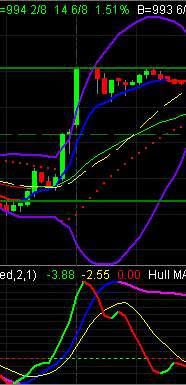
Wheat is proving true to its history of being an up-and-down grain. After hitting a new high overnight (1st chart at right) and reaching its lock limit price, it has retraced until prices have fallen below the close on Friday. That's a fluctuation of more than $.30, and representing 120 ticks. Since each tick is worth $12.50 per contract to a trader, that can amount to good money for a good swing trader. How many Christmas presents could you buy for your family with $1500 ($12.50 x 120 ticks)? The truth is that it is never this easy, so don't be fooled. Most futures traders (90%) consistently lose money. But there are many of us that are able to make a good living at it.
Everyone tends to think that they are the exception to this rule. If you think you are the exception, you AREN'T! If you think this way, you have the pride that will ruin you financially, and humble you in the futures markets! You are literally competing on every trade with the brightest minds in the financial world. If you think you are the cream of the crop, you are probably proud enough to be taken to the cleaners by the experienced traders at hedgers, hedge funds (not the same as hedgers), and the various investment houses. The financial markets have an uncanny ability to humble everyone, even the finest minds in the world, from time to time. Not that I include myself in this category of great minds, but I do include myself in the category of being humbled many times by the futures markets.
However, looking at the daily (and weekly) chart, wheat is still in a solid uptrend. The daily chart is shown here (2nd one from the top of this post). I like these retracements, because they give me a chance to add positions or to position well in trends that I might have missed earlier. "Buy on dips" is a trader's bread and butter during a sustained trend for any commodity.
In my early days of trading, I remember reading that traders who were able to survive for 3-5 years in the market without without losing all their money eventually were able to improve their trading skill sufficiently to become very wealthy in their trading. Over time, they are able to develop both the skills and the temperament to trade successfully and well.
On the other hand the short-term charts are very erratic, and until the market indecision is resolved, conditions are difficult to trade, as shown in this 3-minute chart (bottom). I personally don't take trades during these consolidations, because I don't have the patience to wait for the market to move in a profitable direction. There are people who specialize in these trades, but I have found that price movements between channels/bands is less like a sine wave that is smooth and methodical, and more like a radio frequency wave that is erratic and unpredictable. It's just not worth it to me.
Keep in mind, however, that a consolidation in one time frame may show several trends in a smaller time frame.
Friday, December 14, 2007
Soybean sell-off at the end!
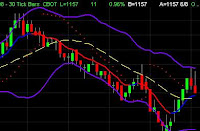 There is almost always a reversal in soybeans at the end of the day as traders take their profits. Many people, including me, don't like to carry trades over the weekend. Many others are day-traders, and liquidate all trades before the close of the day's market session. I like to use this as a way to make additional profits. Thus, I usually execute my last trades between 12:00-12:05 MDT (my local time zone in the Salt Lake City vicinity).
There is almost always a reversal in soybeans at the end of the day as traders take their profits. Many people, including me, don't like to carry trades over the weekend. Many others are day-traders, and liquidate all trades before the close of the day's market session. I like to use this as a way to make additional profits. Thus, I usually execute my last trades between 12:00-12:05 MDT (my local time zone in the Salt Lake City vicinity).
Today, the market began its sell-off about 17 minutes before the market close. That's when I made my last trade. This is prime trading time, since market moves at this time are almost always very smooth and uni-directional. These are some of my best and most reliable trades, too. This is also a time when large funds and hedgers must liquidate quickly to take their profits, so small traders like me can use this to our advantage. I take advantage of these opportunities, closing out my last trades only 2-3 minutes before the session ends at 2:15 EDT. The pictured trade was worth almost $200 per contract, and occurred in only 15 minutes. Just look at how clean that trade was!
I might add, however, that I have NOT found that the market open is equally profitable. The market often moves so rapidly and erratically that it is difficult to trade profitably. I usually wait 5-10 minutes into the trading session before placing my first trade. This is not always the case, but is a general rule for me.
Evening trading can also be profitable between 7:30 - 9:30 pm EST. I ONLY trade using tick charts during these hours. Unfortunately, however, spreads also widen; the bid/ask spread is usually 2-3 ticks during these hours, so they can entail higher risk as well.
U.S. Government deficits on the rise again
Here is some news that hardly makes the media reports, but it's true. Beginning about 3 months ago, the U.S. government has begun to report that budget deficits are rising again. If Congress and the President don't pull out the budget scalpel or raise taxes, the deficits will rise even faster. I haven't heard either seriously talk about cutting the size of government!
Republicans and Democrats BOTH to blame!
While I am politically conservative, and believe generally that less government is better government, Congress and the President are going to have to start cutting spending dramatically or else taxes will have to be raised. Let the record show that I prefer the former. This fiscal ship is heading into a financial tsunami, and no one wants to take responsibility for it. Both Republicans and Democrats are more concerned about maintaining or obtaining greater power than doing what's best for the Republic or the American people.
The Republicans abandoned their principles for the sake of power, and they have now lost both. It's no coincidence!
The Democrats have always believed they have a right to take what belongs to other people, for which there is never an excuse.
I'm disgusted with them all.
Stealing is still stealing whether by hand or by vote!
Why is it that if someone takes the property of someone else with their hands, we call it "stealing" and send them to prison. However, if we hide behind our vote and steal someone else's property via a corrupt politician, we applaud the politician and name freeways and buildings after them. It's still stealing, either way! It's still coveting property of another, either way. I doubt if our Maker is so deceived.
The Founders knew and provided for appropriate government
"The moment the idea is admitted into society that property is not as sacred as the laws of God, and that there is not a force of law and public justice to protect it, anarchy and tyranny commence. If `Thou shalt not covet' and `Thou shalt not steal' were not commandments of Heaven, they must be made inviolable precepts in every society before it can be civilized or made free." -- John Adams (A Defense of the American Constitutions, 1787)
The Founders also provided for effective and limited government, as well as appropriate and sufficient revenues for that limited government in the Constitution, but we have proudly abrogated that precious document and destroyed the Republic they gave us, until now, I believe it hangs by a thread. There will be hell to pay!
Wheat also continues its uptrend
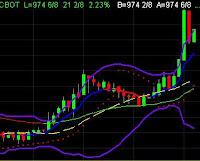
Surprisingly, even with the recent strength of the US Dollar, the grains have all continued moving higher. Today, wheat has also shown great strength! So did corn, but corn is the least volatile of the grains.
Food is going to continue to cost more
Inflation is escalating and accelerating, NOT decreasing. Disinflation is a myth! Higher grain prices are going to add to the cost of most processed foods, meat, and milk. Did you know, for example, that a greater percentage of the higher cost of milk is due to the cost of grain, than the percentage of higher cost in meats is due to the cost of grain? Beef cattle can graze on grass most of the year, only being fattened on grain toward the end of their lives, just before slaughter. However, dairy cattle are fed high-nutrition grains throughout their productive period. Thus, dairy products are more highly impacted by the price of grain than are meat products. That's why milk has risen in price 20-25% over the past year. Both dairy and meat products will have to rise in price even more in the future, however, as the price of soybean meal, corn, wheat, and other grains continue to move skyward. So will all vegetable oils, as will all the products made from grains and their derived oils and other products (meal, flour, etc.).

